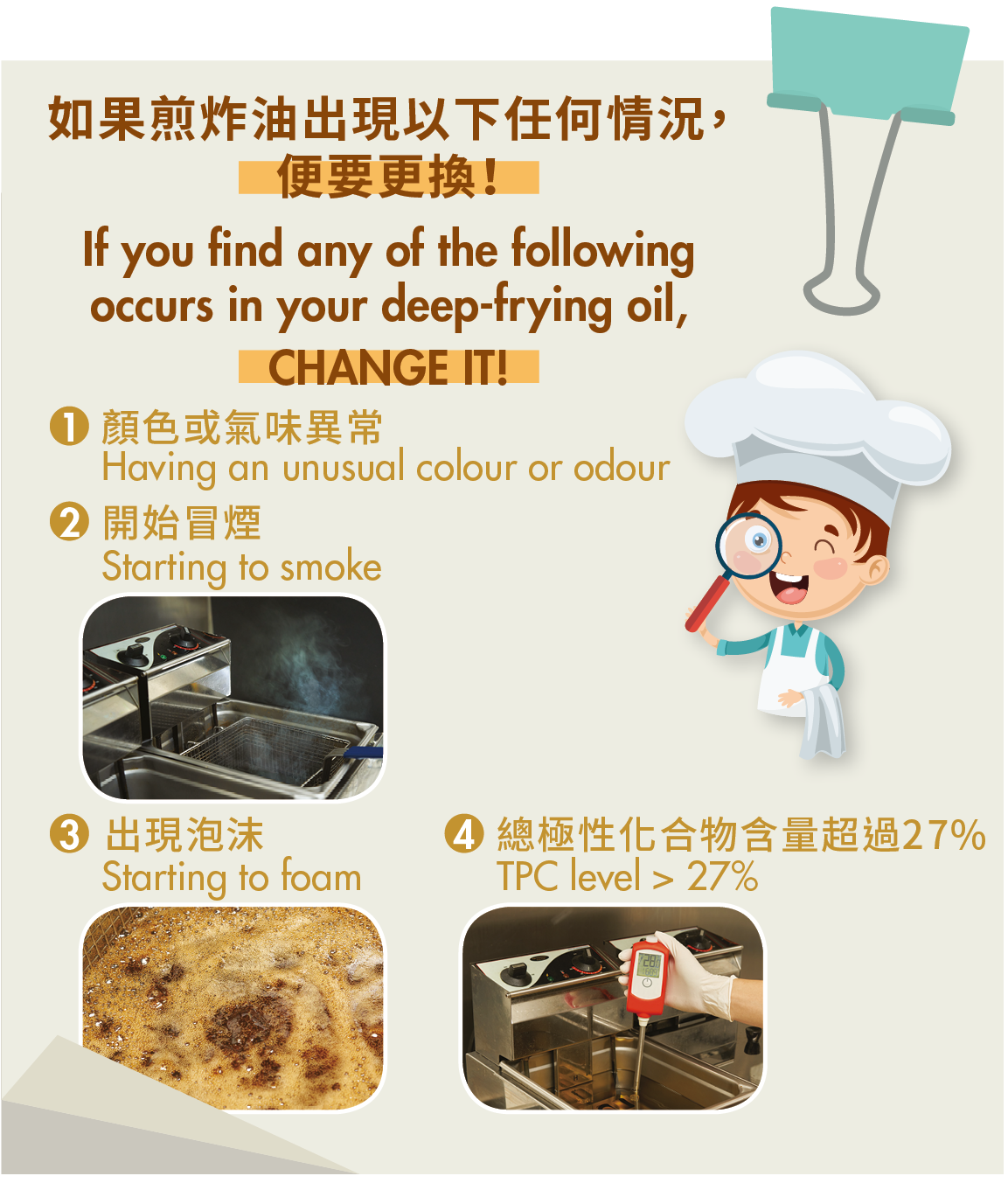
Food Safety Focus (160th Issue, November 2019) – Food Safety Platform
Tips for Using Deep-frying Oil
Reported by Ms. Janny MA, Scientific Officer,
Risk Assessment Section, Centre for Food Safety
Deep-frying is a commonly practised cooking method for making crispy and delicious fried foods, ranging from chips, French toast and doughnuts to spring rolls and tempura, which are appealing to some.
During the deep-frying process, oil is exposed to high temperatures in the presence of oxygen in air and moisture contained in food; a number of chemical reactions occur in the oil. Most chemical compounds resulted from these reactions are relatively polar (i.e. unequal distribution of electrons) in nature, which accelerate the deterioration of oils and may affect quality of oils as well as food safety.

Indicators for changing deep-frying oil
Recommendations on the Use of Deep-frying Oil
With a view to assist local food traders in ensuring food safety and enhancing food quality throughout the deep-frying process, the Centre for Food Safety (CFS) has commissioned a local university to conduct a study and devise a set of “Trade Guidelines on the Use of Deep-frying Oil” (the Guidelines). The Guidelines, developed in consultation with the trade, were published in October 2019 and are now available at the CFS website.
Among other things, the Guidelines recommend the following on the use of deep-frying oil. The public can also make reference to these useful tips when deep-frying food as appropriate:
Before Deep-frying
Among various types of cooking oil, it is important to select suitable ones for deep-frying. Cooking oil with higher levels of monounsaturated fatty acids like rapeseed oil (including canola oil) and high-oleic sunflower oil are relatively stable at high temperatures. Further, they are also beneficial to heart health, making them a more suitable option for deep-frying.
Moisture in food and residues of breadcrumb and batter are known to render oil deteriorated in quality. Therefore, moisture and excessive breadcrumbs and batter on the food surface should be minimised before deep-frying.
During Deep-frying
While using an excessively high temperature accelerates the deterioration of deep-frying oil, using too low a temperature increases oil absorption into deep-fried food. Hence, it is important to control the oil's temperature between 150°C and 180°C during deep-frying.
After Deep-frying
Since small residues in the oil such as food particles and crumbs can char easily and speed up oil deterioration, they should be removed from the fryer frequently. Besides, salt promotes the migration of water from the inside to the surface of the food, leading to hydrolysis of the oil. Therefore, food should be seasoned after deep-frying instead as far as possible.
When the fryer is idle, for example during shift breaks, lower the oil temperature setting to 120-130°C to avoid prolonged heating or frequent heating up and cooling down. When the fryer is turned off, say after business hours, cover it to minimise exposure of oil to light and air which in turn can slow down photo-oxidation and oxidation in the deep-frying oil. Regular cleaning of the fryer can also avoid accumulation of food residues.
When Should We Change Oil?
Since the oil deterioration rate can be affected by various factors, such as types and amount of food it has fried and frying temperature, it may be difficult to recommend changing the deep-frying oil solely based on a fixed time period or the number of times it has been used.
Deep-frying oil should be changed in a timely manner if it has an unusual colour or odour (e.g. a rancid smell), starts to smoke (i.e. smoking of deep-frying oil observed at the recommended frying temperatures (150-180°C)) or starts to foam (i.e. formation of milky foam that cannot dissipate easily). For a more objective assessment, traders may also consider measuring the total polar compounds (TPC) in the deep-frying oil, a comparatively reliable benchmark for measuring the degradation of the oil; oil should be discarded when the TPC value is greater than 27%. Last but not least, topping up of oil should not be used as a means of diluting or prolonging oil use.


